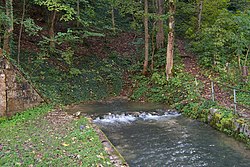| Black Lauter | |
|---|---|
 Source of the Black Lauter in the autumn of 2002 | |
 | |
| Location | |
| Country | Germany |
| State | Baden-Württemberg |
| District | Esslingen |
| Physical characteristics | |
| Source | |
| • location | in Schlatstall, a part of Lenningen |
| • elevation | 535 m (1,755 ft) |
| Mouth | |
• location | confluence with White Lauter, forming the Lauter |
• coordinates | 48°32′19″N9°29′28″E / 48.53861°N 9.49111°E |
• elevation | 470 m (1,540 ft) |
| Length | 2 km (1.2 mi) |
| Basin features | |
| Progression | Lauter→ Neckar→ Rhine→ North Sea |
| Tributaries | |
| • left | Seltenbach |

The Black Lauter (German : Schwarze Lauter) is the left hand source of the river Lauter. It rises in Schlatstall from the Lauterquelle well and the Golden hole. Near Lenningen it joins the White Lauter, forming the Lauter.